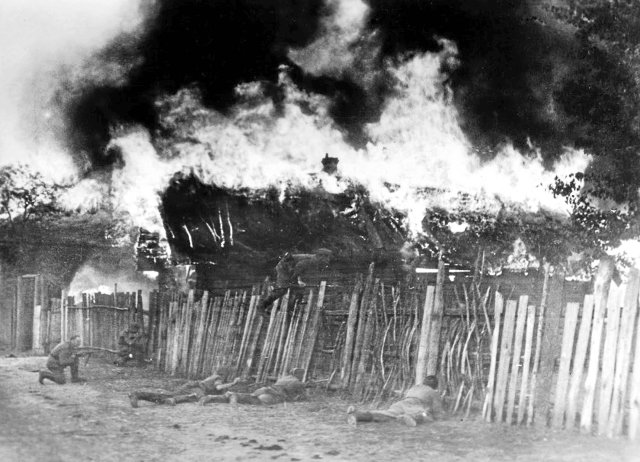Over 9000 villages and settlements were destroyed by the Germans.
Photo: archive
It is impossible to read this book in one go. Like a novel or a non -fiction book, into which you get in to dive into other worlds. With »Feuerdörfer« you need several attempts and extensive breaks. Again and again you want to stop reading, you don’t want to dive into this world when the German Wehrmacht attacked the Soviet Union in 1941. The cruelty are too overwhelming, the horror is overwhelming. Therefore, at this point, it should not be reproduced in detail how people in Belarus were murdered by criminal commands of the Wehrmacht or the SS and burned in houses or barns.
An event is an event that this book can now appear in German for the first time – 50 years after it has been published in Minsk despite the initial reservations of the Soviet censorship authorities. The translator Thomas Weiler performed an enormous performance and rightly received the translator price of the Leipzig Book Fair 2025 on Thursday. This applies to the psychological exertion that it takes to find a language for the unspeakable, and to the challenge of a complex dialectal diversity in Belarusian, which bring these assembled contemporary witness reports. In a workshop report for the Toledo program of the German translator fund, which can be found online, Weiler gives exciting insights into the history of the book and in his work on the book.
Anyone who has read this once has to live with it forever.
The authors Ales Adamowitsch, Janka Bryl and Uladsimir Kalesnik had traveled by Belarus between 1970 and 1973 and had visited 147 towns, where they had 300 conversations. They spoke to survivors and witnesses from the burned villages. Between 1941 and 1944, the Nazi occupiers had destroyed over 9,000 villages and settlements as a criminal campaign against partisans. The film “Come and see” by Elem Klimow from 1985 processes the crimes with the means of cinema.
Even nowadays, when drastic depictions of violence are everyday life, the emotional force and gentlelessness of this film are unmatched. Adamowitsch, who, like the other authors of the book himself, fought as a partisan in resistance, had written the script for the film, based on the reports from »Feuerdörfer« and his own experiences. He was driven by the idea of telling the war as it is – without hero pathos and false hopes. He was looking for a possibility to give a voice to those who had experienced unspeakable. The simple people and their too true stories were not part of the official Sovietidology in literature and art, where victory over fascism had to be glorious and shiny. The Soviet man was not allowed to be a victim. The human suffering in all its shades had little space there.
Together with Janka Bryl and Uladsimir Kalesnik, Adamowitsch transcribed the conversations with the contemporary witnesses and assembled them into a polyphonic collage of suffering and horror, regardless of redundancies or illogical ramifications. The stories should be as immediate as they flowed out of people’s memory. “We saw our task in it,” says the foreword, “the unbearable degree of human pain, the bewilderness and anger, which are not only shown in words, but also to preserve and maintain and maintain voices, eyes and faces in the state of the plasma; To maintain everything that surrounded the man who spoke to us like the air, the people who now turned to the reader on the pages of this book. ”When the book appeared, it triggered a shock in Soviet society. “It is difficult to read this book. Incredible, ”wrote the literary critic Lasar Lasarew. “Nobody had read about the war in this way,” says the Belarusian Nobel Prize for Literature Swetlana Alexijewitsch. “Feuerdörfer” and thus Ales Adamowitsch have decisively shaped their documentaries. “This book has no age,” writes Valzhyna Mort, one of the most famous contemporary poets from Belarus. “The effect is so totally that I do not understand it as such. Once you have read this book, you have to live with it forever. “
Why did it take half a century for this important book to appear in German? Why hasn’t a translation been published at the time of the GDR? Slavician Nina Weller investigated these questions and found out that the Volk and World publisher already had a corresponding translation for discussion in 1974. Was it possibly due to the drastic depictions of violence to decide against a translation? “However, the appraiser showed little,” writes Weller in a contribution to a special of the online magazine decoder.org: »He was particularly disturbed by the compilatory monotonous character of the votes collection and the subjective perceptions of simple people. The authors’ comments were not analytically and too much worn by a didactic, pathetic gesture – the latter criticism had actually accompanied the book since its first appearance. «
The book was still able to develop its power of action, which also shaped the development of a new culture of memory in the Soviet Union and later the work of the human rights organization Memorial until its ban in Putin’s Russia in 2022. However, only by doing the authors of the content of the official ideology in the Soviet Union. Because the Holocaust, which destroyed the rich Jewish culture in Belarus, hardly occurs in the reports. Hardy topics such as that of collaboration or the crimes of the partisans towards their own population are also left out. Nevertheless, “Feuerdörfer” is an important historical document and a key text that belongs to the series of Alexander Solschenizyn’s “Archipela Gulag”, Wassili Grossman’s “Life and Fate” or “The Blockade Book” by Daniil Granin and Ales Adamowitsch. And it is – unfortunately, one would like to say – a very current book.
Ales Adamowitsch/Janka Bryl/Uladsimir Kalesnik: Feuerdörfer. Wehrmacht crimes in Belarus report contemporary witnesses. A. d. Belarus. v. Thomas Weiler. Structure, 587 pages, born, € 39.
pragmatic play sbobet sbobet88 judi bola online
